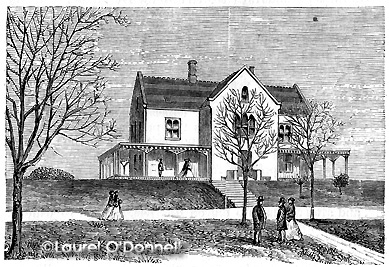|
|
Chapter VI
Institutions of Blackwell's Island.
The New York Almshouse,
page 2 of 2 In 1850 there were in the Almshouse 1,313 persons, or one in 423 of the population. In 1860 there were 1,631 or one in 432 of the population. In 1870 there were 1,114, or one in 808 of the population. The number able to perform service among the females is much less than among the opposite sex. From these are selected the nurses, who keep the wards in order, and care for the old and feeble. The remainder partially demented, crippled, weakened from disease or infirmity, still render such assistance as they are able in sewingand knitting.  Keeper's House. During the year closing January 1, 1870, there were 4,053 persons in the Institutions, of whom 2,979 were admitted, 1,696 discharged, 1,222 transferred to other institutions, 21 died, and 1,114 remained. Of the 2,979 admitted, 363 were Americans, 2,067 Irish, 260 Germans, 163 English; the remaining came from Scotland, Canada, and other countries. They are admitted at all ages, from fifteen years and upwards, Of the 2,979 admitted last year, 46 were under twenty years, 437 between twenty and thirty, 435 between thirty and forty, 507 between forty and fifty, 569 between fifty and sixty, 609 between sixty and seventy, 276 between seventy and eighty, 86 between eighty and ninety, 13 were over ninety, and 1 over one hundred years of age. At least seven-eighths of all thus thrown upon the charity of the city are of foreign birth, and most of the remainder reduced to pauperism by idleness or dissipation. Two wards in the building appropriated to the males, and two in the building for the females, are set apart for the indigent blind, who are sufficiently numerous to require an annual appropriation of $25,000 or $30,000 from the Legislature. The Almshouse buildings are valued at $434,500 exclusive of furniture and grounds. On these grounds are situated also the Hospitals for Incurables. These consist of two one-story wooden pavilions, 175 feet long and 25 feet wide, one of which is devoted to each of the sexes. The inmates are persons afflicted with incurable diseases, but such as require no medical treatment. In addition to the regular Almshouse accommodations, the Commissioners many years ago established a Bureau for the relief of the out-door poor, which has long been managed by an experienced and discreet superintendent (Mr. George Kellock). Until 1867, it was the practice of the Commissioners to appoint several temporary visitors at the approach of winter, to assist the superintendent in examining the condition of those applying for relief, during the cold season. But it was found that from inexperience or indifference the work was so poorly performed, that the city was divided into six, and afterwards into eleven districts, to each of which a visitor was assigned, who not only visits each applicant at his home, but investigates the causes of pauperism, sickness, and crime, in their respective districts, and reports the same to the superintendent. During 1869, the number of families relieved with money amounted to 5,275, with fuel 7,555. More than $128,000 were disbursed through this branch of our public charities alone. The Commissioners have felt the necessity of providing a temporary shelter for the houseless poor, and have repeatedly appealed to the Legislature for authority to lease houses for that purpose. To prevent serious suffering among a class of poor but reputable persons, who from various reasons might be deprived of home, the board, in 1866, fitted up a portion of a prison then unoccupied as a temporary lodging-house. Over two thousand were thus lodged during the winter. Each applicant was questioned, to prevent abuse, and gave satisfactory reasons for destitution. None were admitted who were intoxicated, and in but few instances any who applied the second time. The necessity of restoring the prison to its original use discontinued for the time this arrangement. The superintendent of out-door poor has his headquarters in the central office of the Commissioners, in the new and beautiful building corner of Eleventh street and Third avenue. Here the Commissioners hold their regular business meetings, and preserve the archives of the department. The New York Alms House, for order, neatness, discipline, the general care and comfort of its inmates, compares favorably with any institution of its kind in this or any other country; and the other outside arrangements for the relief of the destitute and the sick, are confessedly administered with marked discretion, and are every way worthy of the great metropolis. |
|
246
:: Previous Page :: Next Page ::
:: Table of Contents :: :: New York State :: :: History Readings :: Books & articles appearing here are modified adaptations
from a private collection of vintage books & magazines. Reproduction of these pages is prohibited without written permission. © Laurel O’Donnell, 1996-2006.
|
|

